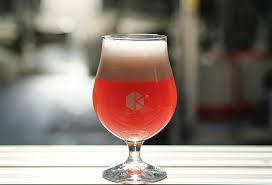Sour Part 3: The Actual Beer Part
SOUR ALE
We've documented our failures. We've began anew. And now we make that actual beer. Making a Sour Ale is a little more delicate than normal beers. Because of the bacterial elements and lactic acid, certain parts of the beer have to be compromised.
There is a lot of prep work that has to be done before the actual brew day. We detailed the starter and its importance in the previous post, and that has to be nice and happy before adding it. As you wait your 5-7 days for the lactobacillus to reproduce, you should be monitoring it. If the flask is quiet, and you can't discern any activity, the bugs are in good shape and are ready to be added to your beer. If there is activity, and you can see action in the flask, something is wrong and you should take care of those issues before continuing on your path to Sour.
As for the beer itself, this observer is of the opinion that it should be relatively simple. Base malt, some flaked, and an adjunct or two that serve a specific purpose. Hops have to be kept to a minimum. Low alpha acid hops added extremely late are the only hop additions that will work, as the oils in the hops themselves act against the souring process. The yeast strain can change according to your preferred profile. Complex strains can be beneficial due to their flavor working well alongside the sour elements, and simpler, cleaner strains will allow the flavors and aromatics of the bugs to thrive.
The initial steps of the beer are simple. Mash and sparge like you normally would, and bring the wort to a boil. Here is where the extra steps start. Boil your wort for a few minutes, and when you get to your hot break, when the surface tension of the boil breaks and you get to a rolling boil, keep it up for about 10 minutes. Then cut the heat. Chill your wort to 110 degrees Fahrenheit, and add a few drops of lactic acid and stir vigorously. Take a pH reading, and add a small amount until you are able to drop your pH to 4.5. Be sure to stir well with each acid addition because it will stay on top of the warm wort until physically folded into the solution. A good guideline is approximately 1 tsp/5 gallons of beer. Lactic Acid goes a long way, so be judicious with how you incorporate it.
Once you reach your 4.5 pH, then add the lactobacillus starter. Do whatever you can to maintain a temperature between 85-110 and let it sit for a few days. Generally it will take 2-4 days for the pH to drop to around 3.7, which is where you want it to stay. The target for the souring is always around 3.7, although some brewers have been able to drop the pH to 3.2, which is super duper sour. How sour you want it is based on your own preferences. We are going to try to hit that 3.7 mark, however, as you let the beer sour, feel free to take a taste when you take your readings (which should be done daily).
Once you get your pH to the perfect sourness for you, then bring the beer back to a boil and finish it off like you normally would. As mentioned earlier, keep the hops to an absolute minimum. Your boil, chill, and primary fermentation should all be done normally, like you were making a simple pub ale. Any kind of fruit addition will be added to a secondary fermentation and allowed to sit in the beer for at least a month. DO NOT DRY HOP. Ever (in a Sour).
OUR RECIPE
10 Lbs Pilsner Malt
1/4 Lbs CaraFoam
1.4 Lbs Acidulated Malt
1 Lb Flaked Wheat
1 oz Teamaker Hops
US-05 Dry American Ale Yeast
Wyeast 5335 Lactobacillus Blend
Lactic Acid
Copious amounts of blueberries
Malts We Use
Pilsner Malt: Pilsner Malt is a classic base malt. Extremely light in color, it is a perfect tableau for beers with a lot of specialty malts. Pilsner Malt has a delicate flavor and is very clean, making it a perfect malt for crisp clear beers. Originally used in most lager styles, it takes its name from the Pilsen beers of Bohemia, where it was developed.
Acidulated Malt: Adding Acidulated malt lowers your mash pH, lightens the overall color of the final beer, and increases the efficiency of the mash.







Comments
Post a Comment